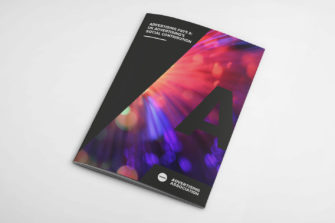Christmas Advertising: Festivity, Gifts and Responsibility
Advertising is at its most powerful around Christmas – what do people think of Christmas ads and what responsibility does the industry have during the festive period?
George Grant, Credos Editor
Most of us who celebrate Christmas can agree that it is a holiday about family and connection. But it is also about the traditions and customs we look forward to once the temperature drops and the nights start to draw in. Christmas exists in the festive mix of spices – cinnamon, cloves, star anise, cardamom; it exists in the sudden appearance of fir trees in the local garden centre and the first bite of a mince pie; and, yes, it exists in the Christmas adverts that we see on our TVs, our streets, and our newspapers.
Adverts are a strong part of that unique Christmas medley. From the moment we notice the first Christmas ad (“surely not, we’re only just taking down the Halloween decorations!”) to the inevitable fighting back of tears while watching the annual John Lewis masterpiece, adverts are a very real part of the Christmas experience.
And adverts have played a similarly important role in the shaping of Christmas today as we know it: following the Victorian era, during which family and gift-giving became central themes of the celebration, mass advertising allowed businesses to use the festive season to sell their products.
Christmas advertising today
The magic of Christmas is such that businesses place huge value and importance on the holiday every year. Data from the Advertising Association/WARC shows that in the UK £9.5 billion is set to be spent on advertising over this year’s Christmas period, representing a 4.8% increase on last year’s record £9 billion, with television retaining £1.5 billion in the quarter. Advertising spend around Christmas has been steadily increasing since records began, and the season has come to play a pivotal role in advertisers’ annual planning strategies. 2023’s rise comes despite Britons having £3 billion less to spend this Christmas. In such a difficult economic climate, brands will be looking to advertising more than ever to stake their claim for the public’s hard-earned pounds this year.
It goes without saying, then, that advertising at Christmas is loved by businesses, but what about the public? To investigate public opinion of Christmas ads, the Advertising Association worked with ‘Opinion Matters’ to conduct a survey of a 2000-strong sample representative of the UK’s regional, age and gender balance. The survey asked people two simple questions: “do Christmas adverts help you get in the mood for the festive season?” and “do they help you with ideas of what presents to give to people?” The results are in, and the story is clear: for many of us, Christmas ads foster festive spirit and help us buy the perfect presents.
Fostering festivity
Our survey found that, of those who celebrate Christmas, 63% think that Christmas ads help them get in the mood for Christmas, particularly women, with almost two in three (66%) agreeing with the statement. Young adults (25-34) are especially affected by Christmas ads, with 74% of those who celebrate Christmas saying that the ads help them get in the mood. This may be due to the age group being linked to early parenthood when Christmas magic is at its strongest. This group has also grown up with the advent of the famous John Lewis ads, an annual tradition that has led to a Christmas campaign renaissance in the UK.
Picking presents
Just under half of us (48%) believe that Christmas ads help us pick out the right presents and, interestingly, that figure is even higher among the 16-34 age groups: combined, 64% of them find that Christmas ads help them with their gift-giving decisions. It makes sense that advertising helps in this way – after all, two of advertising’s primary functions are to help customers choose between products and to find new ideas. Whether that be an outdoor ad for a local Christmas gift fair, or a big budget campaign for this season’s must-have toy, advertising lets people know about the options, new and familiar, available to them.
Advertising’s responsibility
As much as advertising has positive influences over the festive season, it also bears considerable responsibility, especially during a period in which some can feel pressured into spending beyond their means. Credos found in its most recent quarterly survey into public trust in advertising that one-third of people can feel that advertising puts pressure on them to spend money. Interestingly, these views towards Christmas advertising are in line with the ‘fostering festivity’ and ‘picking presents’ findings, with younger people feeling more positive than older respondents: only a quarter of 18-34-year-olds felt pressure to spend, compared to 40% of 55-74-year-olds and 58% of over-75s.
The ASA and Clearcast have clear rules on what brands and advertisers can and can’t do around the Christmas season to curb as much of this pressure as possible. It is our responsibility to make sure that we are conscientious about messaging, and following those rules is fundamental to this.
ASA and Clearcast Christmas rules
Excessive spending
This first one relates specifically to Credos’ finding about pressure to spend at Christmas. The ASA stresses that, especially during such a financially tough year, it is advertisers’ duty not to encourage excessive spending. ‘Buy now pay later’ schemes need particular caution, to ensure that advertisers do not encourage excessive spending through the use of credit.
Alcohol advertising at Christmas
According to the Bank of England, in the UK, spend on alcohol increases markedly in December compared to the average month. Parties and family gatherings inevitably lead to a jump in sales, but the ASA and Clearcast both have very clear rules on the portrayal of excessive or irresponsible drinking at Christmas. CAP rules are require that no one looks, or is, under 25 in alcohol advertising, while the ASA stress that depictions of irresponsible quantities of alcohol being served or consumed have caused campaigns to be pulled for breaching their rules.
Christmas imagery
There are some images advertisers frequently call on to invoke the spirit of Christmas. Snowball fights, crackling fires and carol singers, while popular images and traditions, have been earmarked by Clearcast as potential hazards for advertisers. No snowballs should be thrown in the face of innocent bystanders, decorations shouldn’t be hung over lit fires, and carols must not be shown sung alongside gambling, alcohol, or violence.
Remember your audience
Christmas is an especially magical time for children, so advertisers must be particularly thoughtful during the period. The ASA line on kids is very clear: “Advertisers must ensure that any ads targeting or featuring children are not exploiting their credulity, loyalty, vulnerability, or lack of experience by making them feel inferior for not buying (or encouraging others to buy) an advertised product”.
Respecting Father Christmas
Somewhere between adolescence and adulthood, people can pick up the misconception that Santa Claus might not be real. Any adverts containing this message – that Santa Claus is a myth and doesn’t exist – are kept firmly away from younger viewers by Clearcast. As Clearcast quite rightly say: “don’t ruin the magic”.
A Christmas Conclusion
Christmas is a time when the advertising industry is reminded of its powerful role in society, and the responsibility that this brings. Our work brings genuine joy to millions and can be a great tool for helping people choose gifts for one another as well as a crucial lever for businesses to capitalise on increased market activity. But clearly there is a line to be walked to ensure that people aren’t pressured into buying items they can’t afford. We should be grateful for the good work that the ASA and Clearcast do and encourage advertisers to keep working with our regulators to make sure that every Christmas ad is as responsible as it is magical.
Export value in real terms
Inflation continues to be a general concern, both domestically and globally. Pent-up demand from the pandemic, tightness in the labour market, supply chain disruptions, and the war in Ukraine have all contributed to rising prices. As a result, central banks have engaged in monetary tightening since 2022 in an attempt to rein in inflation.
Real terms value adjusts export value to take inflation into account, making it a better guide to growth in exports as it removes price effects that may distort the data.
[Insert Figure 3]
Figure 3. Comparison of Export Value in Current and Real terms. Source: ONS UK trade in services: service type by partner country, non-seasonally adjusted (Released: 26 January 2023)
We examine the effect of inflation on export value growth using a GDP deflator (See Annex B). The GDP deflator can be viewed as a measure of general inflation in the domestic economy and can be used to determine export growth in real terms (Figure 3).
Using 2016 as our base, the actual and real terms lines diverge over time, but the rate of divergence is most significant in 2020 and 2021. In 2021 the difference between actual and real terms export growth was as much as 12%.
Considering the rate of inflation in 2022 the lines will start to diverge far more dramatically once we have the full results for 2022.
Interest rates
To combat inflation, many central banks across the world, including the Bank of England, have embarked on a path of monetary tightening. Monetary policy includes several policy tools but the key one is interest rates because of its direct effect on consumers, requiring borrowers to pay more in interest payments on loans and savers to earn more for deposits.
Although inflation is expected to fall from its current highs by the middle of the year, particularly as energy prices have fallen, there is some concern that inflationary pressures will remain at persistently high levels. At the time of writing, the Federal Reserve and European Central Bank have taken a more hawkish tone and are indicating further interest rate rises this year. A member of the Bank of England’s monetary policy committee indicated that to get the UK to its 2% target annual inflation rate would require interest rates to rise further from their current 4% level.
Exchange rate impact
One effect of interest rate movement is its impact on exchange rates. For example, if the Federal Reserve increases its base rate, it tends to make dollar-denominated bonds and interest-rate product more attractive and hence the dollar stronger. Some argue that a lower exchange rate relative to the dollar may help export competitiveness in the short run.
Comparison of Quarterly Export values in GBP and USD (Top chart). Average quarterly GBP/USD exchange rate (Bottom chart). Source: ONS UK trade in services: service type by partner country, non-seasonally adjusted (Released: 26 January 2023). ONS Average Sterling exchange rate: US Dollar XUMAUSS (Released 10 February 2023)
The top chart in Figure 4 shows the comparison of quarterly export values in GBP and USD terms. The bottom chart is a time series of the average quarterly GBP/USD exchange rate.
From 2016, there is a positive overall trend of quarterly export value, which is increasing over time. On the other hand, we can see a gradual decline in the exchange rate between the GBP and USD. In practical terms, the pound exchanging for less dollars mean that UK exports are cheaper when priced in USD.
From the data, there does not seem to be any negative impact on the growth of exports. However, this will be little consolation to importers and companies who report revenue in USD.
From 2018 onwards, there is increasing volatility in the quarterly numbers, with simultaneous declines in export value and exchange rate recorded around Q3 2022 being particularly noticeable. Greater volatility can make it difficult for buyers to plan and optimise value (why buy today if prices might be cheaper tomorrow?). That said, given that the numbers are subject to revision it is too early to say for certain what effect the sharper decline in GBP/USD rates in Q3 2023 is having on exports. We will know with greater certainty in our next report.
UK House heads to UAE
The UK Advertising Exports Group and DIT will host its next virtual trade mission to the UAE as part of its new series of #TradeTuesday events through the creative sectors virtual venue, UK House.
UK House at UAE will feature 90 minutes of high-quality discussion and presentations by leaders and innovators from both advertising industries. This will be followed by exclusive roundtables to network and meet potential new business partners.
You can meet the UK companies taking part in these exclusive roundtables by downloading our UK advertising, made global brochure here.
UK House in UAE takes place on October 19th at 11am(BST) /2pm (GST). Speakers include Natalie Amos, Four Communications presenting a new white paper on the consumers driving the travel industry’s recovery and a a series of behind closed doors roundtables with clients and companies in market.
You can register for your ticket to attend here.
The Climate Action Round-Up From UK Advertising’s Ad Net Zero Team
Welcome to our regular round-ups of climate action news through the lens of the UK advertising industry’s climate initiative, Ad Net Zero.
We take a look at climate-related news and opinions from within our industry and also the big things for advertising professionals to consider about how the work they produce can make a positive contribution to climate action. For more on Ad Net Zero, check out our Climate Action page.
“The best time to plant a tree? Yesterday” Inside adland’s rapid efforts to turn sustainable
While the UK prepares to host a UN summit on climate change (COP26) in November, agencies and brands are accelerating efforts to reduce their carbon footprint as the climate crisis becomes business critical.
Carbon calculators and combatting greenwash: How will the advertising sector reach net-zero?
Edie explores how the advertising sector is collaborating to meet the milestone of reaching net-zero by 2030, while also spurring a wider culture change that informs the public on sustainable products and services.
The “carbon calculator” that will let agencies measure their CO2 footprint
AdGreen, the low-carbon arm of the Advertising Association, is to make its carbon calculator freely available to all in the UK advertising industry in September 2021.
Why 2021 could be a giant leap for sustainable advertising production
With AdGreen’s new resources guide, carbon calculator and an industry levy to fund it, this year could see a step change in how production views its carbon footprint.
Green list puts eco-friendly companies on the map
The growing companies powering Britain’s green economy have been mapped for the first time by the ScaleUp Institute and the research firm Beauhurst.
Why experience is the next creative frontier for hybrid events
Max Pinas, Creative Director at Dept, on why brands should merge physical and virtual experiences to create next-level events.
Bringing the House of Commons to Cannes
The House of Commons came to Cannes on the morning of Tuesday June 18 as delegates from across British advertising came together to debate on the importance of creativity in a business’ success. Newsworks Communications Manager Hannah Ohm-Thomas takes us through the debate.
The British advertising industry’s leading figures came together today to debate the case for and against the motion that creativity is the most important factor in a business beating its competitors.
Proposing the motion was adam&eveDBB co-founder James Murphy joined by Grey London CMO Sarah Jenkins. Kicking off the debate, Murphy discussed the definition of creativity and how – through new ideas and perspectives – it has transformed markets and businesses, allowing them to differentiate and boost their value.
For British institutions like John Lewis, for every £1 invested in marketing, £25 is generated in profit. And big business is recognising the value placed on creativity, recently signalled by Accenture Interactive’s acquisition of creative advertising agency Droga5.
To second the motion, Jenkins focused on people. Commenting that without human inspiration we cannot drive businesses forward – machines don’t ask questions, but people do, and it is that curiosity that creates results. Murphy concluded, “we could have all had an mp3 player, but then Apple brought out the iPod” – the room smiled.
Next up, opposing the motion was Senior Analyst at Bloomberg Matthew Bloxham together with futurefactor Client Partner Sarah Taylor. Speaking on the importance of doing rather than just thinking, Bloxham used Thomas Edison’s quote “genius is 1% inspiration and 99% perspiration” as the foundation of their argument.
Unpacking “perspiration”, the duo discussed business disciplines such as sound customer service, consistency of execution, diversity of workforce, speed, and efficiency and how they provide revenue.
Using the example of diversity as a way to drive results – something that is being widely discussed at Cannes Lions this year – according to McKinsey “the top 20% of gender diverse businesses, provide 27% more value creation”.
“Business is a sum of parts” said Taylor and they have to be dynamic to be able to move the needle. Although the pair acknowledge that creativity is good for business, the ability to effectively harness its power and translate that into value is key.
Bloxham’s summarised the opposition’s argument with “execution is the most important thing in the cocktail of business success.”
The proposition secured the votes they needed to win the motion, with all credit to the opposition for a very compelling argument.
The panel was moderated by Stephen Woodford, Chief Executive, Advertising Association. The International Advertising Association (IAA) is a fellow member of The Debating Group.






